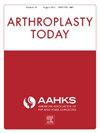术中透视可降低全髋关节置换术后腿长不一致的程度和发生率
IF 1.5
Q3 ORTHOPEDICS
引用次数: 0
摘要
背景全髋关节置换术(THA)后,腿长不一致(LLD)会导致患者不满意和功能下降。本研究探讨了术中透视对 THA 术后 LLD 的程度和发生率的影响。方法对接受初级 THA 的患者进行鉴定,并根据 4 种手术方法中的一种以及术中透视的使用情况将其分为若干队列。每个队列都纳入了最近的 100 名匹配患者。通过心尖间参考线到小转子的测量,对术前和术后 LLD 进行影像学评估。分析 LLD 的大小以及每个队列中 LLD 为 5 mm、10 mm 和 15 mm 的患者比例。总体而言,与不进行透视的 THA 相比,进行透视的 THA 产生的腿长偏差更少。透视下的前路肌肉疏松(ABMS)方法的术后LLD(3.4 vs 5.1 mm,P = .01)明显少于无透视的后路方法(3.4 vs 4.8 mm,P = .03),无透视的侧位ABMS方法的术后LLD(3.4 vs 4.8 mm,P = .03)也明显少于无透视的侧位ABMS方法(3.4 vs 4.8 mm,P = .03)。对于 LLD >5毫米,与不进行透视的 ABMS 方法相比,进行透视的 ABMS 方法的患者人数明显较少(23 对 41,P < .01)。对于 LLD >10毫米,有透视的 ABMS 方法队列中的患者数量明显少于无透视的后部方法队列(2 vs 15,P < .01)。结论本研究提供的证据表明,使用术中透视可能有利于降低 THA 术后 LLD 的幅度,并减少 LLDs >5mm、>10mm 和 <15mm离群的发生率。本文章由计算机程序翻译,如有差异,请以英文原文为准。
Intraoperative Fluoroscopy Decreases Magnitude and Incidence of Leg-Length Discrepancy Following Total Hip Arthroplasty
Background
Leg-length discrepancy (LLD) can lead to patient dissatisfaction and decreased function after total hip arthroplasty (THA). This study examines the impact of intraoperative fluoroscopy on the magnitude and incidence of LLD after THA.
Methods
Patients undergoing primary THA were identified and stratified into cohorts based on one out of 4 surgical approaches and intraoperative fluoroscopy use. The most recent 100 patients matching each cohort were included. Preoperative and postoperative LLD was assessed radiographically via an interteardrop reference line to lesser trochanter measurement.Magnitude of LLD and the proportion of patients in each cohort with LLD >5 mm, >10 mm, and 15 mm were analyzed.
Results
Four hundred patients were stratified into 4 equal cohorts. Overall, THA done with fluoroscopy yielded fewer leg length discrepancies than THA done without fluoroscopy. The anterior-based muscle sparing (ABMS) approach with fluoroscopy had significantly less postoperative LLD than the posterior approach without fluoroscopy (3.4 vs 5.1 mm, P < .01) and the ABMS approach in the lateral position without fluoroscopy (3.4 vs 4.8 mm, P = .03). For LLD >5 mm, the ABMS approach with fluoroscopy cohort had significantly fewer patients compared to the ABMS approach without fluoroscopy (23 vs 41, P < .01). For LLD >10 mm, the ABMS approach with fluoroscopy cohort had significantly fewer patients compared to the posterior approach without fluoroscopy (2 vs 15, P < .01). For LLD >15 mm, relative to the posterior approach without fluoroscopy, all other cohorts had significantly fewer outliers (P < .02).
Conclusions
This study supplies evidence that use of intraoperative fluoroscopy is likely beneficial in reducing the magnitude of LLD following THA and reducing the incidence of outlier LLDs >5 mm, >10 mm, and <15 mm.
求助全文
通过发布文献求助,成功后即可免费获取论文全文。
去求助
来源期刊

Arthroplasty Today
Medicine-Surgery
CiteScore
2.90
自引率
0.00%
发文量
258
审稿时长
40 weeks
期刊介绍:
Arthroplasty Today is a companion journal to the Journal of Arthroplasty. The journal Arthroplasty Today brings together the clinical and scientific foundations for joint replacement of the hip and knee in an open-access, online format. Arthroplasty Today solicits manuscripts of the highest quality from all areas of scientific endeavor that relate to joint replacement or the treatment of its complications, including those dealing with patient outcomes, economic and policy issues, prosthetic design, biomechanics, biomaterials, and biologic response to arthroplasty. The journal focuses on case reports. It is the purpose of Arthroplasty Today to present material to practicing orthopaedic surgeons that will keep them abreast of developments in the field, prove useful in the care of patients, and aid in understanding the scientific foundation of this subspecialty area of joint replacement. The international members of the Editorial Board provide a worldwide perspective for the journal''s area of interest. Their participation ensures that each issue of Arthroplasty Today provides the reader with timely, peer-reviewed articles of the highest quality.
 求助内容:
求助内容: 应助结果提醒方式:
应助结果提醒方式:


